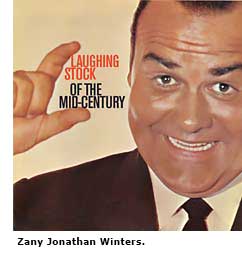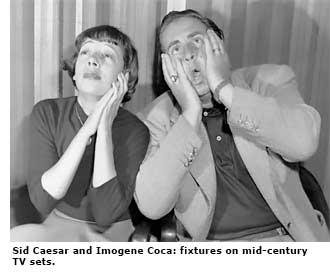Laughing Stock of the Mid-Century

Some funny things happened on the way to the second half of the 20th century: America found new ways to laugh and new places to do it.
With shifts towards progressive theater, social issues, and psychoanalysis following World War II, performers uncovered plenty of source material for comedy and tantalizing ways to dish it up. At the same time, the evolving media of home entertainment—television and the long-playing record player, as well as radio—gave many practicing comedic performers the means to reach audiences far larger than the clubs and halls to which they'd been limited.
As with any other genre of performance or art, mid-century comedy was neither absolutely new nor absolutely distinct. For a case study, take Sid Caesar, please. Prior to becoming a TV celebrity in the early 1950s, Caesar performed on saxophone and in sketches in New York State's Catskills region, where an older style of comedy—a patter of short jokes and one-liners—had become institutionalized at summer resorts. Caesar had also entertained his fellow troops while enlisted in the Coast Guard, and his personal experience helped him understand what postwar audiences might be seeking.
"These men who came out of the war appreciated being alive," Caesar pointed out in an interview in the 1990s. "Crying and laughter are one and the same emotion...and America was tired of crying. There had been a depression, we'd just been through a war, there was a lot of pain...So you wanted to get something to take your mind off."
The pain was somewhat staved off by an infusion of hope. "You came back from the war, and you could go to college because of the G.I. Bill," Caesar said. "You didn't have to live in the city, you could have your own home."
Caesar found himself ensconced on the large, wood-framed television sets that were becoming a fixture in the living rooms of the new mid-century dream homes across the county also made possible by the same the G.I. Bill. His 'Your Show of Shows,' on Saturday night on NBC from 1950 through 1954, centered on hilarious, satirical sketches featuring Caesar and his petite partner Imogene Coca, with a cast including Carl Reiner appearing in other sketches.
Helping them serve up the funny stuff at the International Theatre in New York City was a staff of what Caesar called "the world's best writers," whose impact on comedy persisted for decades. Two of them, Neil Simon and Larry Gelbart, went on to create very funny plays and situational comedies (sitcoms) for TV. One, Mel Brooks, would be cutting up all over: in a comedy team (with Reiner) and as a film scriptwriter, director, and actor. And another, Woody Allen, after developing his own prolific stand-up career, would become an Oscar-winning writer and director of both comedies and dramas.

Out on the West Coast, without benefit of a network broadcast, comedy struggled to fit in among the live acts at nightspots such as the hungry i and the Purple Onion in San Francisco's North Beach, the neighborhood of the Beats.
Jerry Nachman, then a journalism student at San Jose State College (and now Gerald Nachman, the author of a resourceful study of mid-century comedy, Seriously Funny), was among the curious youth who frequented the San Francisco club scene back then. "It was a different kind of comedy—different from radio and TV, Jack Benny and Bob Hope, which I loved too," Nachman recalls. "These [new] people were making social commentary, satirizing society...making a difference."
One of the first of what would come to be called stand-up comedians booked at the hungry i was Mort Sahl, a frustrated playwright from Southern California who, as Nachman suggests, looked and sounded like nothing that had preceded him. Sahl tickled minds and funny bones by reading between and behind the lines of the San Francisco Chronicle, which he held rolled up in his fist as a prop. And he'd discarded the suit and tie of the older funny men in favor of a collegiate sweater and jeans.
Bay Area columnists and critics and the hip club goers among their readership served as a launching pad for several comedy stars, including Sahl, who in turn took the new brand of comedy across the country. Sahl also advanced the form by recording what may be the first stand-up comedy long-playing (LP) album.
Among those following Sahl's geographic and professional paths to the hungry i, the nearby Purple Onion, and beyond was Lenny Bruce, whose act displayed both the common themes and the variety of approaches among mid-century comedians. Bruce had a critical intellect as sharp as Sahl's, as well as a fast-paced delivery, but Bruce also had an appetite for sexual references and obscenity, which gained him a different kind of public notice: repeated brushes with the law.




